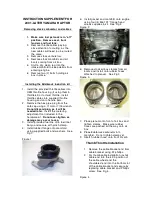
2005 Volvo S80
The vehicle's curb cargo + passengers.
NOTE:
• The location of the various labels in your vehicle can be found on
page 144
.
• A table listing important weight limits for your vehicle can be found on
page 145
.
Steps for Determining Correct Load Limit
(1) Locate the statement "the combined weight of occupants and cargo should never exceed XXX
pounds" on your vehicle's placard.
(2) Determine the combined weight of the driver and passengers that will be riding in your vehicle.
(3) Subtract the combined weight of the driver and passengers from XXX kilograms or XXX pounds.
(4) The resulting figure equals the available amount of cargo and luggage load capacity. For example, if
the "XXX" amount equals 1400 lbs. and there will be five 150 lb. passengers in your vehicle, the amount
of available cargo and luggage load capacity is 650 lbs. (1400-750 (5 x 150) = 650 lbs.)
(5) Determine the combined weight of luggage and cargo being loaded on the vehicle. That weight may
not safely exceed the available cargo and luggage load capacity calculated in Step 4.
(6) If your vehicle will be towing a trailer, load from your trailer will be transferred to your vehicle.
Consult this manual
1
to determine how this reduces the available cargo and luggage load capacity of
your vehicle.
WARNING!
- Exceeding the permissible axle weight, gross vehicle weight, or any other weight rating limits can
cause tire overheating resulting in permanent deformation or catastrophic failure.
- Do not use replacement tires with lower load carrying capacities than the tires that were original
equipment on the vehicle because this will lower the vehicle's GVW rating. Replacement tires with a
higher limit than the originals do not increase the vehicle's GVW rating limitations.
1
See "Towing a trailer" on
page 89
.
file:///K|/ownersdocs/2005/2005_S80/05s80_07.htm (14 of 21)12/30/2006 4:38:28 PM
















































